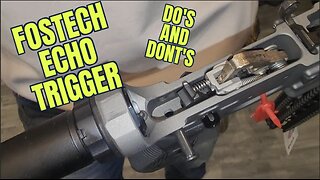Premium Only Content

Wearing the proper shoes for construction jobs is crucial for ensuring safety, comfort, and performance on the job site. Here are some key considerations when choosing construction work shoes:
Safety Toes:
Steel-toe boots: Protect your toes from falling objects and compression. They are a common choice for construction sites.
Electrical Hazard Protection:
EH-rated boots: If you work around electricity, choose boots that provide electrical hazard protection.
Slip Resistance:
Slip-resistant soles: Construction sites can be slippery, especially in wet or oily conditions. Look for shoes with slip-resistant outsoles to prevent accidents.
Ankle Support:
High-top boots: These provide additional ankle support, reducing the risk of twists and sprains.
Waterproofing:
Waterproof boots: If you work in wet or muddy conditions, consider boots with waterproofing to keep your feet dry.
Comfort:
Cushioning and support: Construction work can be physically demanding. Choose shoes with adequate cushioning and arch support to reduce fatigue and enhance comfort during long hours.
Durable Materials:
Look for boots made from durable materials such as leather or synthetic materials designed for rugged conditions. This helps ensure the longevity of your footwear.
Proper Fit:
Make sure your shoes fit properly. Boots that are too tight or too loose can lead to discomfort and foot problems.
Breathability:
If you work in hot conditions, consider boots with breathable materials to prevent excessive sweating and discomfort.
Compliance with Safety Standards:
Ensure that your work boots comply with relevant safety standards and regulations in your industry or region.
Arch Support:
If you have specific arch support needs, consider insoles or boots designed with adequate arch support.
Remember, the specific requirements for construction work shoes may vary based on the nature of the job and local safety regulations. It's essential to prioritize safety and choose footwear that meets or exceeds the necessary standards for your work environment. Additionally, regularly inspect and maintain your work shoes to ensure they continue to provide the protection you need.
-
 51:51
51:51
Randi Hipper
1 hour agoBITCOIN PRICE FACES VOLATILITY AS ALTCOIN TAKE A HIT! LATEST MARKET UPDATE
4.62K1 -
 LIVE
LIVE
Wendy Bell Radio
6 hours agoDaddy's Home
12,152 watching -
 1:16:53
1:16:53
Graham Allen
3 hours agoCanada FOLDED!! Trump Wins Trade War With The 51st State! + The Department Of Education Is DONE!
34.8K41 -
 LIVE
LIVE
2 MIKES LIVE
2 hours agoTHE MIKE SCHWARTZ SHOW with DR. MICHAEL J SCHWARTZ 02-04-2025
237 watching -
 19:40
19:40
Neil McCoy-Ward
2 hours ago🚨 I’ve Never Seen Anything Like It! (I Spent The Day Reading The ‘USAID’ Payments Log - WTF!?)
7.13K11 -
 7:53
7:53
Misha Petrov
16 hours agoThe CRINGIEST Moments From The Grammys
22.9K91 -
 5:57
5:57
China Uncensored
20 hours agoLiving in China Comes With Some Risks
58.9K28 -
 12:32
12:32
Bearing
1 day agoAustralian Gender Clinic Caught SECRETLY Transitioning Kids 🤬🤬
46.8K79 -
 4:34
4:34
AlaskanBallistics
1 day ago $1.81 earnedFosTech Echo Trigger
27.1K14 -
 9:10
9:10
ariellescarcella
14 hours agoI Asked People To Toss Out An Identity : The Queer Alphabet Is OVER
20K11